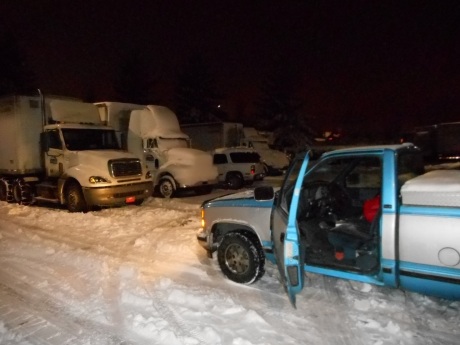Epistemic Collapse
13 April 2017
Thursday
Not long ago in Snowstorm Reflections on Collapse and Recovery I discussed some of the experiences likely to be related to a local and limited collapse of social institutions, as a way to consider broader and deeper scenarios of social collapse. In this connection I quoted the following from Joseph Tainter’s The Collapse of Complex Societies:
“Collapse, as viewed in the present work, is a political process. It may, and often does, have consequences in such areas as economics, art, and literature, but it is fundamentally a matter of the sociopolitical sphere. A society has collapsed when it displays a rapid, significant loss of an established level of sociopolitical complexity. The term ‘established level’ is important. To qualify as an instance of collapse a society must have been at, or developing toward, a level of complexity for more than one or two generations. The demise of the Carolingian Empire, thus, is not a case of collapse — merely an unsuccessful attempt at empire building. The collapse, in turn, must be rapid — taking no more than a few decades — and must entail a substantial loss of sociopolitical structure. Losses that are less severe, or take longer to occur, are to be considered cases of weakness and decline.”
Joseph A. Tainter, The Collapse of Complex Societies, Cambridge: Cambridge University Press, 1988, p. 4
For Tainter, collapse is sociopolitical collapse, but we need not be limited by this stipulation. There are potentially many different meanings of “collapse” and I would like to particularly focus on what I will call epistemic collapse, which has played at least as prominent a role as social collapse in the extinction of civilizations.
A definition of epistemic collapse, that is to say, a catastrophic loss of knowledge, can closely parallel Tainter’s definition of social collapse, like this:
A society has epistemically collapsed when it displays a rapid, significant loss of an established level of knowledge (epistemic complexity). The term ‘established level’ is important. To qualify as an instance of collapse a body of knowledge must have been at, or developing toward, a level of complexity for more than one or two generations. The epistemic collapse, in turn, must be rapid — taking no more than a few decades — and must entail a substantial loss of epistemic structure. Losses that are less severe, or take longer to occur, are to be considered cases of epistemic weakness and decline.”
Tainter emphasizes that a “collapse” implies a previous level of attainment and stability (continuity); I agree with Tainter that this is an important qualification to make. It should also be pointed out that collapse implies a subsequent stability of the lower level of complexity and attainment, perhaps for a generation or two. In other words, a collapse — whether social, epistemic, or otherwise — means that stability and continuity at a higher level of complexity and integration is rapidly replaced by stability and continuity at a lower level of complexity and integration.
We know that one of the reasons the European “Dark Ages” were dark was the loss of the accumulated knowledge of classical antiquity, or, if not the loss (in an absolute sense), its restricted access due to loss of educational institutions, reduction in the publication, copying, and distribution of books, reduction in literacy, and so forth. During this period of reduced access to knowledge, some knowledge was lost in an absolute sense. Some books deteriorated or were destroyed before they were copied, and so have been lost to history. Much of the tradition of educational institutions was lost, as the educational institutions of classical antiquity went extinct or were extirpated (Justinian ordered the closing of the philosophical schools of Athens in 529 AD) and were subsequently replaced by educational institutions attached to the Catholic Church.
To reach further back into the past, around 1200 BC there was a generalized collapse that led to the extinction of several Bronze Age civilizations (this story is recounted in Eric Cline’s book 1177 B.C.: The Year Civilization Collapsed). This severe blow to civilization led to a significant epistemic collapse characterized by widespread loss of literacy throughout the ancient world. Homer, we recall, was recounting an “ancient” time of heroes and heroic deeds, and it has been speculated that the Homeric corpus was the translation into written form of oral poetry that survived from this dark age of more warfare and less reading as compared to the age that preceded it.
In the kind of generalized collapse resulting in the extinction of civilizations that characterized the Late Bronze Age, there was both social and epistemic collapse, but to what extent are these two modalities of collapse separable? Even if not instantiated in human history, is it possible for a civilization to remain socially stable while experiencing epistemic collapse, or to remain epistemically stable while experiencing social collapse? I think that counterfactuals could be constructed to illustrate the possibility of isolated social or epistemic collapse, but these would not be very convincing without some historical parallel to make the point. A possible example could be the destruction of the Library of Alexandria, which was not tightly-coupled to a social collapse, but which entailed a significant epistemic loss, or the Mongol destruction of Baghdad in 1258, which, again, was not tightly-coupled to social collapse (except for the collapse of Baghdad itself) but was a disaster for learning and certainly issued in permanently lower levels of epistemic attainment in the region. For an illustration of the opposite isolation, it is arguable that Byzantium preserved the epistemic record of Roman civilization even as all Roman social institutions collapsed and were replaced.
The above considerations suggest that a distinction should be made between collapse (of some particular kind) and the extinction of a civilization. Only the most generalized collapse over several classes of human endeavor result in the extinction of civilization, and we can obtain a more finely-grained appreciation of how societies ultimately fail and civilizations go extinct (or resist extinction) by separating social, financial, legal, religious, and epistemic collapse, inter alia.
Multiple collapses result in the extinction of civilization. Civilization is itself a complex institution that is comprised of many sub-institutions; that is to say, civilization is an institution of institutions. We can classify the institutions that go on to make up a civilization as social institutions, economic institutions, legal institutions, epistemic institutions, and so on. All of these institutions are intertwined in civilization, but it sometimes happens that even an integrated institution within civilization will collapse without the civilization of which it is a part collapsing. The many intertwined institutions that together constitute civilization mutually support each other and can bring a civilization through a difficult time if enough of these institutions persist despite the failure of other institutions.
If our nascent scientific civilization were to experience an epistemic collapse, but the social institutions of our civilization retained a significant measure of continuity, our civilization could enter into a state of permanent stagnation (something I noted as the greatest existential risk of our time in Where Do We Come From? What Are We? Where Are We Going?). If, on the other hand, we provide a robust backup of our knowledge, so thorough that a social collapse is not also an epistemic bottleneck, we could see the social institutions we know disappear even while our knowledge was largely intact and propagated into the future. Thus the human future itself admits of possible isolated social or epistemic collapse. Something like our civilization would survive on the other side of this collapse, after the recovery or replacement of the failed institutions, but that civilization would be fundamentally altered by the process.
. . . . .
. . . . .
. . . . .
. . . . .
Snowstorm Reflections on Collapse and Recovery
15 January 2017
Sunday

Early in the history of this blog I wrote about a snowstorm in Portland during December 2008, Snow in Portland, More Snow, and Lessons from a Snowstorm, and now Portland has had another uncharacteristically heavy snowfall eight years on. I am always fascinated to watch the rapidly changing behaviors of the population of a city as it responds to rapidly changing conditions, and I can’t help but extrapolate from these observations to other disruptions to the ordinary business of life.

The initial impact of a big snowstorm (in a temperate climate where snowstorms are infrequent) is chaos and frantic activity. After the initial chaos, the city goes quiet, and driving around a city after it has gone quiet gives an apocalyptic feeling, as though the end of the world has come. A snowstorm is, in miniature, the collapse of a complex society, such as Joseph Tainter wrote about:
“Collapse, as viewed in the present work, is a political process. It may, and often does, have consequences in such areas as economics, art, and literature, but it is fundamentally a matter of the sociopolitical sphere. A society has collapsed when it displays a rapid, significant loss of an established level of sociopolitical complexity. The term ‘established level’ is important. To qualify as an instance of collapse a society must have been at, or developing toward, a level of complexity for more than one or two generations. The demise of the Carolingian Empire, thus, is not a case of collapse — merely an unsuccessful attempt at empire building. The collapse, in turn, must be rapid — taking no more than a few decades — and must entail a substantial loss of sociopolitical structure. Losses that are less severe, or take longer to occur, are to be considered cases of weakness and decline.”
Joseph A. Tainter, The Collapse of Complex Societies, Cambridge: Cambridge University Press, 1988, p. 4
Of course, the collapse precipitated by a snowstorm is not a political collapse, but it is a rapid and significant loss of an established level of complexity, and a temporary return to a simpler way of life.

When someone abandons their car and walks away, eventually walking around their neighborhood rather than driving, this is a significant simplification of life, and the simplest level to which life can be reduced is that of mere survival, or perhaps I should say subsistence. Because the conditions of a snowstorm or a flood or some similar disruption (say, a power outage) are temporary it does not force a return to subsistence agriculture, but there are occasions when one finds oneself no longer concerned by the technical details of one’s work, and one is only fighting to stay alive, as all other considerations are thrust aside in order to deal with the immediacy of the circumstances. However, it is easy to imagine (especially with the looming specter of climate change) that a storm could be the first disruption in a series of escalating disruptions that could force society to abandon its complex institutions and way of life, returning to subsistence agriculture, or even nomadic hunting and gathering. If a large flood failed to recede after a few days because water levels had crept higher, the disruption of the the storm that caused the flood would be a mere foretaste of things to come.

There is a great deal of social momentum behind the ordinary business of life, and one can observe that people continue to go about their routines in the routine way for as along as possible — right up the moment when it becomes actually physically impossible to continue to going about things as usual. Thus one sees people setting out for work as usual even as the snow is beginning to fall, and as the snow piles up they try to continue to go about their business. It is only when, on the drive home, their car will not move forward another inch, when they abandon it and walk away. As long as a choice remains, most will choose to continue with the ordinary business of life; the routine is only abandoned when no choice remains and one is forced by circumstances to alter one’s behavior.

There is also a strong desire to return to normalcy after the disruption of a storm, so that at the first sign of conditions improving, people head out again in large numbers. In the case of the snowstorms I have seen in my years, this creates a problem because the main roads will be cleared of snow, but the secondary roads and parking lots are still icy, and many people over-confidently driving at full speed on the highways cause problems for themselves and others. The desire for the return to normalcy is a desire for the familiar normalcy, the old normal, while the conditions of the storm, strange and unfamiliar at first, dictate a new normal, and there is a tension between the old normal and the new normal as society attempt to adjust and compensate for changed conditions. As long as the conditions of the new normal are temporary, the old normal will return, but the longer the conditions persist, the longer the new normal persists, and, as the phrase implies, the new normal eventually becomes familiar if it endures for a sufficient period of time.

I imagine that in the case of the true collapse of societies, and not merely an ephemeral collapse precipitated by a weather event, that this desire to return to normalcy results in a lot of false starts, like commuters returning to the roads too soon after a snowstorm. There are probably many hopeful moments in the collapse of a society when people come out of their hiding places and venture out into the world again, hoping that they can return to their routines. When Sarajevo was under siege during the Balkan wars of the 90s, it was several years before life could return to normal. Similarly, when the First and Second World Wars began, it would be several years before normalcy would return.

When a society well and truly collapses, never to rise again, one can imagine for years or for decades people looked for a return to normalcy that would never come. Or if life seemed to return to normal for a time — for weeks or months or years — it was only a deceptive return to old ways that would soon disappear forever. When Roman cities in the west began to fail, there was probably a movement like the ebb and flow of the tide, when people would abandon their city, then go back, then abandon it again. Each time those who returned would be fewer in number, there would be fewer shops open, and fewer goods for sale, and there might be increasing lengths of time between abandonment and return, until eventually the period of abandonment stretched into years, and the city fell into disrepair, fit only for looting from the ruins.
. . . . .
. . . . .
. . . . .
. . . . .





